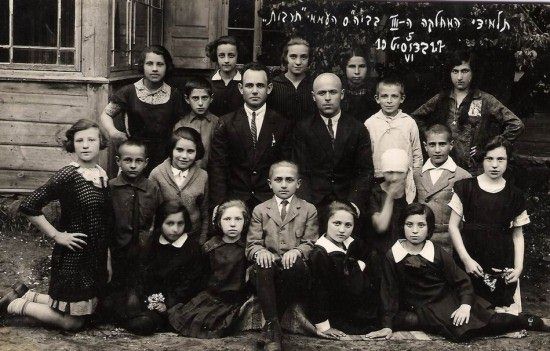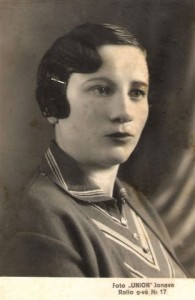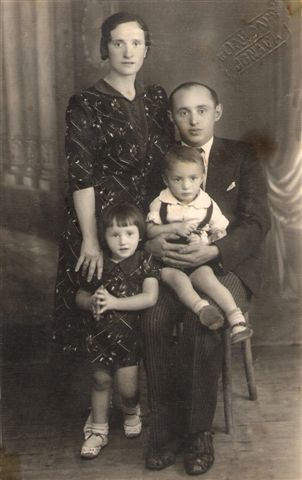[Pages 221-222]
Family Devotion
By Masha Gershuni (Slep)
Translated by Judy Grossman
In my time there were activities of both Hashomer Hatzair and Hechalutz Hatzair in the shtetl. I joined the Hechalutz Hatzair club. Mirka Baron was also in my group. Among my counselors were Rivka Levitt and Froike Zeligson. The club met in the home of Feige (the daughter of Rivel) Rabinowitz on Maskevitcher Gass (Street). The club did not have activities on Friday nights. There was no electricity and we didn't dare light a lamp on the Sabbath. At home we sat as long as the lamp burned, and after that we went to bed.
I went to school in Dusiat, and Arie [Gershuni] attended school there at the same time. He originally came from Vizun [Vyzuonos], but when he was orphaned he moved to Dusiat to live with his Aunt Bashe Mate's, his father's sister. Later on Arie and his brother moved to Kovno [Kaunas]. His brother studied bookkeeping and worked in a manufacturing shop, and little Arie was placed in an orphanage.
Dr. Siegfried Lehman of Berlin, a physician and preeminent educator and a Zionist, founded and for many years directed the “children's home” (Kinderheim) in Kovno. This institution took in hundreds of orphaned and abandoned children who were in the city after World War I. This was a unique educational project, which opened its doors to the influence of various ideological movements. Later on this institution sent its children and educators on aliya to Eretz Yisrael and continued its work as Kfar Hanoar Ben Shemen, an institution that was also initiated, founded and administered by Dr. Lehman.
Shayke Glick: A program was formulated at that time to gather orphans together in the children's home in Kovno and afterwards send them on aliya to Eretz Yisrael. A delegation came to Dusiat and tried to convince my widowed mother to send one of her children, in order to ease the financial hardship in the house. I remember that my mother spread her hands and asked: “Can I cut off one of these fingers?” and she didn't hand over a child.
When we recall memories of that time, Arie always mentions the great respect they had for their teachers. When he encountered the teacher Yudel Slep in Vilna he called to him, in Hebrew: “Adoni Hamoreh!” [Sir Teacher]. Arie was proud that Yudel recognized him immediately. We treated the teachers with great respect.
In 1928 the children's home directed by Dr. Lehman moved to Ben Shemen in Eretz Yisrael, and Arie was with them. I was twelve years old when Arie left Dusiat, but we continued to correspond throughout the entire time.
|
|
| Third Form Pupils in the Tarbut Folk School in Dusiat – June 5, 1927
From right to left, top: Libke Kasimov, Rivka Pores, Batya Glezer, Gitele Musilewitz, Belke Krut
Second row: Reuven Milun, Beinishke Yudelowitz, teachers Yehuda Slep (son of Chaya-Tzipe) and Hillel Schwartz, Moshe-Berke Blacher
Third row: Mirka Baron, Honke (son of Rochel-Leah Glick), Masha Slep (daughter of David Mordechai and Sara)
Kneeling: Yocheved Zalkind, Etzka Slep (daughter of Yudel and Rachel-Gitel),
Rivka-Goldke Shub, Moshe Visakolsky, Mirka Karanowitz, Itale Charit |
Hachshara[1] in Yanove [Jonava]
At the age of seventeen I left for the hachshara in Yanove, despite my parents' objection. I worked in agriculture there, and that was hard work! I picked strawberries in the field and also baked bread. I used to knead the dough in the bakery, a huge amount in a gigantic barrel, and because I am short, I had to stand on a stool so that my hands would reach the dough.
My sister Frida and our cousin lived in Yanove, but what member of a hachshara would go live with relatives? All the joy was to be with the group.
I frequently recall Yanove, which was located on the bank of the river on which floated wooden rafts that were used for carpentry. Indeed Yanove excelled in carpentry!
The hachshara period came to an end and I returned to Dusiat and began waiting to receive a certificate[2] [for Eretz Yisrael]. There was a tremendous desire to make aliya! That was the only topic of conversation. We used to travel a great distance to get to the Hechalutz head office in Kovno to ask: “When will we make aliya? When will our turn arrive?”
Arie was already in Kibbutz Naan and had received citizenship of Palestine - Eretz Yisrael. We corresponded by mail, and I expressed my wish to make aliya. I sent him six hundred lit and he came to Lithuania so we could marry. I remember that there was great excitement upon his arrival in Dusiat. They had, after all, known him from childhood.
Our wedding took place in my brother's home in Kovno, on the eve of Passover, and my mother and sister were also there. My father was already ill, and died a month later.
We made aliya to Eretz Yisrael on June 5, 1935. That was after the shloshim [thirty days of mourning] for my father, and I remember that I was really heartbroken then. The sorrow over my father's death, the parting from home, from my mother, my sister and my brother… But the desire to make aliya to Eretz Yisrael was stronger than everything else. We had no future in the shtetl. Most people began moving. Entire families left.
Family Warmth
Devotion to one's family was the norm in the shtetl. We didn't live in luxury, but there was enough for everyone, and even more. My older sister Chana lived in Ushpol [Uzpaliai] and her situation was dire. Her husband Berl-Leibke Shur was a hat maker, and more than once it happened that he ordered and paid for fabric that never arrived, and all his money was lost.
My mother Sara (Bogord) used to give me food for them, and I used to walk for three hours to bring it to them. But before that, at daybreak, I still managed to take the cows out to pasture…
My mother used to buy lamb's wool from the Gentiles and she used to spin the wool on Yudel Aires' (Dovid-Leib's uncle) spinning machine, knit socks and weave kerchiefs.
In general, handicrafts were very popular, but not everyone was talented at them. My sister Frida was a specialist at handicrafts, and I remember that she wove a beautiful wall hanging!
My last regards from home were brought to me by Yitzchak Poritz. I remember that he brought me dry black bread wrapped in a bag from my mother (how delicious it was!), a jar of varenei (jam) and a piece of soap. Elka Melamed brought me linen cloth for a dress.
In 1940 I received the last postcard from my brother, and from then on all contact was lost, forever!
During a trip to London I passed by a large park with plants exactly like “die mindernes”, which grew on the island in our lake. I recall that we used to plait “life preservers” from the reeds. There were also yellow and white flowers there, similar to the flowers that we called “kaleteike”. When I saw them they immediately brought my memories of my shtetl Dusiat to mind.
|
|
Freidke (Slep) and her husband Shaul Beten
[son of Avraham and Henne, from Yanove]
with two of their three children |
Footnotes
- Training farm or workshop to prepare people for life in Eretz Yisrael Return
- British permit for immigration to Palestine. Return
This material is made available by JewishGen, Inc.
and the Yizkor Book Project for the purpose of
fulfilling our
mission of disseminating information about the Holocaust and
destroyed Jewish communities.
This material may not be copied,
sold or bartered without JewishGen, Inc.'s permission. Rights may be
reserved by the copyright holder.
JewishGen, Inc. makes no representations regarding the accuracy of
the translation. The reader may wish to refer to the original material
for verification.
JewishGen is not responsible for inaccuracies or omissions in the original work and cannot rewrite or edit the text to correct inaccuracies and/or omissions.
Our mission is to produce a translation of the original work and we cannot verify the accuracy of statements or alter facts cited.
 Dusetos, Lithuania
Dusetos, Lithuania
 Yizkor Book Project
Yizkor Book Project
 JewishGen Home Page
JewishGen Home Page
Yizkor Book Director, Lance Ackerfeld
This web page created by Lance Ackerfeld
Copyright © 1999-2024 by JewishGen, Inc.
Updated 21 Mar 2008 by LA





